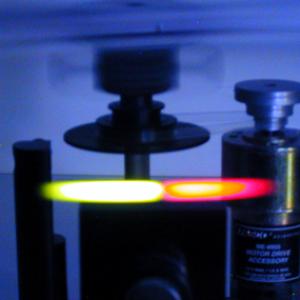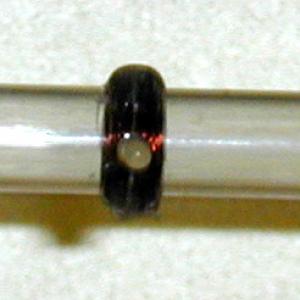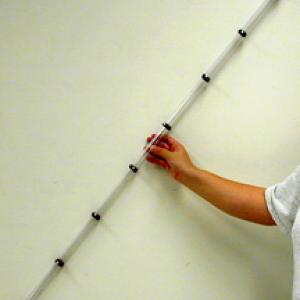College of Liberal Arts & Sciences
5K10.25 - Electromagnetic Induction Demo - Coil and Light Bulb with Magnets
The Pasco Faraday's Law apparatus allows you to spin the coil through the magnet at a constant rate. The direction of the current in the coil is then indicated by either the green or the red LED.
Place a long neodymium magnet into the tube that has the eight coils connected to the bi-colored LED's. The LED's are oriented so that one pole of the magnet will give all greens, and the other pole will give all reds. Slide the magnet down the tube with sufficient speed to light seven of the coils as it falls.
The flashlight is based on some high tech parts. A low current, high intensity, white LED, a large multi-farad capacitor, and Faraday's law of induction. Shake the battery through the coil a few times to charge up the capacitor. This will store enough energy to light the LED for up to 30 minutes.
- F. Behroozi, "Electromagnetic Induction and Lenz’s Law Revisited", TPT, Vol. 57, #2, Feb. 2019, p. 102.
- Deborah Wood and John Sebranek, "Electromagnetic Induction With Neodymium Magnets", TPT, Vol. 51, #6, Sept. 2013, p. 344.
- Emily Alden, Mark Kennedy, Wolfgang Lorenzon, and Warren Smith, "An Electromagnetic Induction Flashlight Experiment", TPT, Vol. 45, #8, Nov. 2007, p. 492.
- Joe L. Ferguson, "A Supersensitive LED Faraday's Law Demonstration", TPT, Vol. 39, #7, Oct. 2001, p. 444.
- Editor's Note, "Addition", TPT, Vol. 37, #1, Jan. 1999, p. 3.
- Charles A. Sawicki, "Improved Flashbulb Demonstration of Faraday's Law", TPT, Vol. 36, #6, Sept. 1998, p. 370.
- Dan Lottis and Herbert Jaeger, "LED's in Physics Demos: A Handful of Examples", TPT, Vol. 34, #3, Mar. 1996, p. 144.
- John W. Jewett, "Get The LED Out", TPT, Vol. 29, #8, Nov. 1991, p. 530.
- C. Lopez and P. Gonzalo, "Using LED's To Demonstrate Induced Current", TPT, Vol. 27, #3, Mar. 1989, p. 218.
- C. L. Hamilton, J. H. Hamilton, D. A. Burba, and E. A. Jones, "Some Electrical Demonstrations Using Strong Permanent Magnet", TPT, Vol. 25, #4, Apr. 1987, p. 223.
- B. G. Eaton, "Free Fall, Induction, and the Oscilloscope", TPT, Vol. 12, #2, Feb. 1974, p. 115.
- Dhananjay V. Gadre, Harch Sharma, Sangeeta D. Gadre, et al., "Science on a Stick: An Experimental and Demonstration Platform for Learning Several Physical Principles", AJP, Vol. 91, #2, Feb. 2023, p. 116.
- Robert Kingman, S. Clark Rowland, and Sabin Popescu, "An Experimental Observation of Faraday's Law of Induction", AJP, Vol. 70, #6, June 2002, p. 595.
- Robert Ehrlich, "9.3, Induced Currents Using LED's", Why Toast Lands Jelly-Side Down", p. 149.
- Andy Graham, "Faraday's Law in a Flash", PIRA Newsletter, Vol. 3, #7, November 18, 1988, p. 3.
- Don Rathjen and Paul Doherty, "Stripped-Down Generator", Square Wheels, 2002, p. 125.
Disclaimer: These demonstrations are provided only for illustrative use by persons affiliated with The University of Iowa and only under the direction of a trained instructor or physicist. The University of Iowa is not responsible for demonstrations performed by those using their own equipment or who choose to use this reference material for their own purpose. The demonstrations included here are within the public domain and can be found in materials contained in libraries, bookstores, and through electronic sources. Performing all or any portion of any of these demonstrations, with or without revisions not depicted here entails inherent risks. These risks include, without limitation, bodily injury (and possibly death), including risks to health that may be temporary or permanent and that may exacerbate a pre-existing medical condition; and property loss or damage. Anyone performing any part of these demonstrations, even with revisions, knowingly and voluntarily assumes all risks associated with them.





